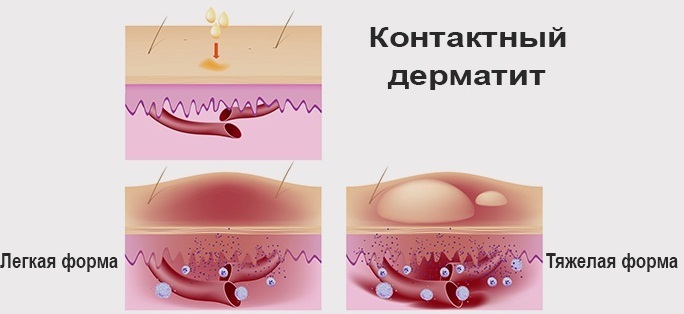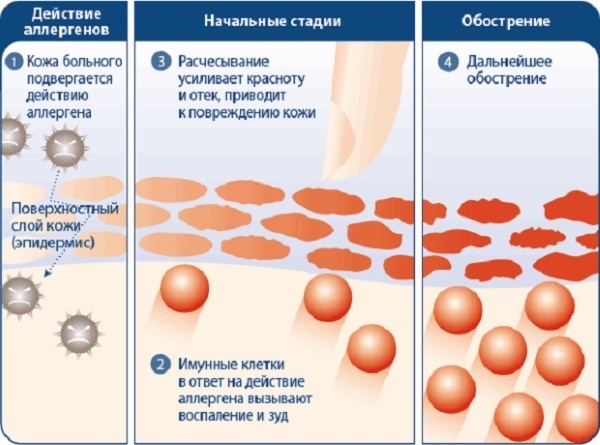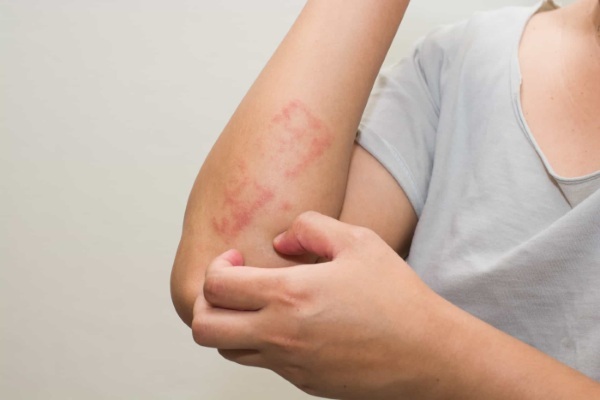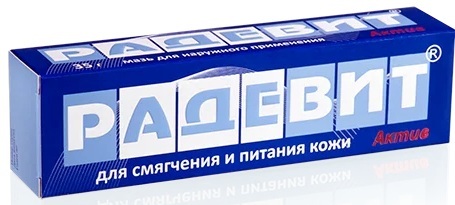Content
- Forms of contact dermatitis and features of their treatment with drugs
- Simple contact dermatitis
- Contact allergic dermatitis
- What groups of drugs are effective against contact dermatitis
- Names and instructions for use of drugs
- Skin softeners
- Topical corticosteroids
- Corticosteroid tablets
- Local non-hormonal agents
- Combined funds
- Antihistamine ointments
- Antiseptics for the prevention of infections
- Wound healing creams
- How to independently develop a course of treatment for contact dermatitis
- Complications of contact dermatitis in the absence of therapy
- Contact dermatitis video
Redness, soreness and itching, puffiness and dryness of the skin are signs that may indicate development of contact dermatitis. The cause of the pathology is contact with certain substances. Some ointments and creams help to improve a person's condition. For the treatment to be effective, when choosing a drug, it is necessary to take into account the area of skin lesion, the features of the course of the disease, the risk of side effects.
Forms of contact dermatitis and features of their treatment with drugs
Contact dermatitis occurs when certain substances interact directly with the skin. Distinguish between a simple form of pathology and an allergic one. Each of them, in turn, is acute, subacute and chronic.
Simple contact dermatitis
This form of the disease occurs most often. The reason for its occurrence is the effect of various toxic substances, which provokes the destruction of the skin and the development of the inflammatory process. Contact can occur both at work and at home. Sometimes a single contact with some drugs is enough to develop dermatitis. Other substances provoke the onset of the disease only with regular interaction with the skin.
The pathological process can be triggered by:
- kerosene;
- phenols;
- organic solvents;
- caustic soda;
- lime;
- acids.
After contact with a caustic substance, bubbles form on the skin. Mild irritants lead to redness and dryness of the skin, the formation of cracks. For severe cases, the occurrence of edema, wetness, pain is characteristic. Simple dermatitis often affects the hands and skin of the face.
Depending on the stage, the disease can be:
- erythematous;
- vesicular;
- necrotic.
The goal of therapy is to restore the epidermis and protect it in the future from the effects of irritating agents. In the chronic form of pathology, it is recommended to contact less with soap and water, regularly use softening creams, gloves to protect hands. The acute stage of pathology sometimes requires the use of glucocorticoids externally and internally. But therapy will be ineffective if contact with the substance that provokes unpleasant symptoms is not eliminated.
Contact allergic dermatitis
Contact dermatitis, treatment (ointments and creams are selected individually) which must be started after a thorough diagnosis, may be of an allergic nature. A negative reaction can occur as a result of prolonged regular contact with a provocateur (nickel, perfumes). But sometimes a single interaction is enough (for example, some plants can cause unpleasant symptoms).
The disease can be caused by:
- low molecular weight chemical compounds, metal ions (nickel, cobalt, chromium);
- some plants (poison ivy, primrose, chrysanthemum);
- drugs for topical use;
- cosmetics, hair dyes;
- rubber, glue.
At first, a person suffers from severe itching, then itchy rashes appear. Signs do not always appear immediately after interacting with an allergen, so it is often difficult to determine what exactly triggered the disease. Chronic dermatitis can last for several months or several years.
The affected area on the body turns red, swells, rashes appear, the location of which depends on the cause of the pathology. For example, if the allergen contains decorative cosmetics, then the skin of the face will suffer, a nickel ring will cause damage to the finger.
Depending on the stage, the pathology can be:
- erythematous;
- vesicular;
- weeping;
- cortical;
- squamous.
Treatment includes general measures and the use of medications. It is important to avoid contact with the allergen, adhere to a hypoallergenic diet. If contact cannot be avoided, the skin in exposed areas must be protected with personal protective equipment. Of the drugs, glucocorticoids are used in the form of ointments and creams. Severe cases of contact dermatitis require the use of antihistamines and systemic glucocorticoids.
What groups of drugs are effective against contact dermatitis
Contact dermatitis, treatment (ointments and creams, tablets and other drugs are prescribed depending on the cause of the reaction) which is not started in a timely manner, threatens the development of serious complications. Therefore, if unpleasant symptoms appear, you need to visit a specialist as soon as possible.
If the skin is slightly affected, you can get by with the use of local remedies:
- creams or ointments with glucocorticosteroids;
- combined drugs with glucocorticosteroids, antifungal components.
If more than 20% of the skin is affected, systemic therapy will be needed using:
- glucocorticosteroids;
- antihistamines;
- immunosuppressants if standard treatment fails.
With the transition of the disease into a chronic form, long-term use is necessary external corticosteroid agents. Additionally, the use of moisturizing and emollient preparations is recommended.
Names and instructions for use of drugs
Contact dermatitis, the treatment (ointments and creams are used most often) of which is often prolonged, significantly worsens the patient's life. The main symptoms that bother the patient are itching and swelling.
Prescribed medications should alleviate a person's condition:
- cool the skin;
- relieve itching;
- reduce redness and swelling.
Skin softeners
Emollients not only relieve itching, but also accelerate skin healing, relieve inflammation, and eliminate dryness. The composition of such drugs is different, but the effect is similar.
Preparations for softening the skin:
| Name | Action | Application | Contraindications |
| Bepanten | Stimulates the restoration of the skin, normalizes metabolic processes at the cellular level. It has moisturizing and mild and anti-inflammatory properties. | A thin layer of the drug is applied to the affected area several times a day. The duration of therapy is determined individually and depends on the degree of skin damage. | Excessive sensitivity to the constituents of the product |
| Panthenol | Restores damaged skin, accelerates epithelialization and scarring of affected tissues. | Apply to the damaged area of the skin several times a day. The duration of therapy depends on the severity of the pathological process. | Individual intolerance to the components of the product |
Topical corticosteroids
Such drugs are used in severe cases or with a protracted form of the disease, since their components affect the balance of hormones in the body. Means of this category quickly eliminate the manifestations of the disease, relieving annoying itching, redness, reducing irritation and rash. Medicines should be prescribed only by a doctor, they can be used for a short time in order to avoid the development of complications (pigmentation, skin atrophy, development of renal failure).
The doctor may recommend such remedies:
- Hydrocortisone ointment. The cheapest and weakest remedy. It has anti-inflammatory, anti-allergic and antipruritic properties.
-
Celestoderm. It has a pronounced antibacterial effect, has vasoconstrictor and anti-inflammatory properties. The drug is recommended for use in case of secondary infection.

- Advantan. Suppresses the inflammatory process, eliminates allergic manifestations. To increase the effectiveness of treatment, it is recommended to use the agent with other antifungal drugs.
- Fucicort. It has anti-inflammatory and antibacterial properties. The course of therapy should not exceed 14 days.
- Akriderm. Eliminates allergic manifestations. Stops the inflammatory process, accelerates the regeneration of the skin, relieves itching and burning;
- Dermovate. Possesses pronounced anti-inflammatory, antipruritic properties. The drug is recommended for use when other hormonal agents do not have the desired effect.
The main disadvantage of these drugs is addiction. Over time, the hormonal agent may not be effective.
Also, topical corticosteroids often cause side effects. Unpleasant symptoms can occur if you use the product for too long or incorrectly. It can even lead to skin atrophy or adrenal insufficiency.
Another disadvantage of drugs in this group is the withdrawal syndrome. Therefore, it is not recommended to interrupt the course of therapy or skip the treatment of the skin. This can lead to a return of symptoms of the disease. It is necessary to finish treatment gradually, reducing the frequency of use and the dose of the drug.
Hormonal agents for topical application are contraindicated in:
- sexually transmitted diseases;
- tuberculosis;
- pregnancy and lactation;
- herpes;
- bacterial or fungal skin lesions.
Corticosteroid tablets
Corticosteroid tablets are used for severe illness. Most often, doctors recommend the use of Dexamethasone, Prednisolone, which have anti-inflammatory, immunosuppressive, antitoxic, anti-allergic properties.
Such medicines should not be taken for more than 7 days, as long-term therapy can cause various side effects:
- edema;
- leaching calcium from bones;
- decreased immunity;
- pressure surges;
- increased blood glucose levels;
- dysfunction of the gastrointestinal tract;
- cycle disorders in women;
- deterioration of the skin;
- psychoemotional disorders;
- increase in body weight.
It is not recommended to take medicines of this group for patients who suffer from:
- severe forms of hypertension;
- circulatory disorders;
- tuberculosis;
- diabetes;
- endocarditis.
Therapy with hormonal drugs is prohibited for women carrying a baby and breastfeeding.
Local non-hormonal agents
Non-hormonal local remedies have a minimum of side effects. They are used even in childhood, as well as during the period of carrying a baby and breastfeeding. But at the same time, such drugs are not effective enough. The therapy can take months. Moreover, in order to achieve a positive result, the treatment must be continuous.
Most often prescribed.
- Eplan. Possesses a wide spectrum of action. Restores the skin, moisturizes it, destroys pathogenic microorganisms, eliminates itching. The drug can be used even for babies. The only contraindication is excessive sensitivity to the constituents of the product. Cream therapy can be long-term, it does not cause addiction.
-
Radevit. A product with a combined composition. Helps to restore damaged skin, has an anti-inflammatory effect, relieves itching and burning, enhances the protective properties of the skin. It is not recommended to use the drug simultaneously with hormonal agents.

- Gistan. A drug based on dimethicone, which forms a thin film on the skin, protecting it from damage. Also, the product is distinguished by the content of medicinal plants, essential oils. The cream stimulates and improves metabolic processes, activates blood circulation, and prevents the occurrence of infectious complications.
- Fenistil. It has anti-allergic and antipruritic properties, relieves irritation. It can be used in children from 1 month of age.
Combined funds
For the purpose of treating pathology, combined drugs can be prescribed:
- Pimafukort. Differs in antimicrobial, antifungal properties, eliminates the inflammatory process. It is used if the disease is complicated by the addition of an infection. Contraindications to the use of the remedy are viral skin lesions, open wounds, acne.
- Cortomycetin. Combined agent with anti-inflammatory, anti-allergic and antimicrobial properties. Fungal, viral skin lesions, violation of its integrity are contraindications to the use of the drug.
- Hyoxysone. Has antibacterial effect, has anti-inflammatory properties. The product contains a glucocorticoid. It is not recommended to use the remedy for viral skin lesions, precancerous diseases, pathologies such as syphilis, tuberculosis.
Antihistamine ointments
The general task of antihistamines is to reduce the production and release of histamine, a mediator of allergic reactions. Also drugs of this group provide narrowing of blood vessels, elimination of edema and redness, accelerate the healing of lesions on the skin. The funds are applied in a thin layer to the affected area of the skin 2-3 times a day. Therapy is stopped after symptoms have subsided.
They have pronounced antihistaminic properties:
-
Elokom. It is a hormonal agent with antiallergic properties. The drug allows you to eliminate allergic symptoms, improves immunity at the local level. Long-term use of the medication can cause the development of side effects, such as skin atrophy, increased drowsiness, and acne.

- Afloderm. It has antihistaminic properties and also provides an antibacterial effect. When using the product, you must strictly adhere to the instructions, since adverse reactions may occur.
Antiseptics for the prevention of infections
As an antiseptic for dermatitis with weeping erosion, experts recommend using Chlorhexidine. The drug is used both to treat the resulting blisters and to prevent infection.
Also, for the treatment of affected skin areas, use:
- brilliant green;
- Fukortsin.
Iodine is not recommended for these purposes. If the affected area remains dry, neutral pastes, talcum powder and special powders can be used. It should be remembered that soap and other detergents should not be used when washing the affected skin.
Wound healing creams
You can speed up skin healing with homeopathic remedies and vitamin-based ointments. Fresh or old wounds are treated with such drugs. Fresh lesions can be lubricated with Dexpanthenol. The tool accelerates the restoration of the skin, normalizes metabolic processes at the cellular level, helps to increase the strength of collagen fibers, has weak anti-inflammatory properties.
Old lesions can be treated with Actovegin, which activates metabolic processes in tissues, improves trophism and stimulates recovery processes. Also, the vitamin ointment Radevit has healing properties, which has an antipruritic, anti-inflammatory effect, accelerates the healing process of the skin.
How to independently develop a course of treatment for contact dermatitis
Contact dermatitis, treatment (ointments and creams, means for oral administration are selected individually) which is usually long-term and is aimed not only at eliminating symptoms, but also at preventing exacerbations, it can also pass on one's own.
But for this it is necessary to protect the skin from repeated exposure to the irritant. A person prone to the development of such a pathology should be very responsible about their own health and independently take measures to prevent the occurrence of unpleasant symptoms.
If an allergen is identified, the patient will have to avoid contact with it throughout their life. But in some cases this is impossible (at home or at work), therefore, before interacting with an irritant, you will have to take antihistamines.
In addition, the mandatory rules should be:
- wearing gloves in cold weather;
- washing hands with warm water using gentle detergents;
- regular use of moisturizing and emollient creams that prevent skin dehydration.
Caring for the skin and maintaining its integrity is the main task of patients prone to developing dermatitis. If you minimize the impact of irritating factors, you can get rid of the inflammatory process even without the use of drugs.
Complications of contact dermatitis in the absence of therapy
Contact dermatitis, the treatment (ointments and creams are better for treating children) which was carried out incorrectly, can be complicated by the addition of an infection. In this case, you should consult a doctor to change the drug. This will allow you to quickly take control of the situation. If the impact of an external factor was too aggressive, rough, visible scars on the skin may remain.
But most often the disease responds well to treatment, and the only complication may be a change in skin color in the affected area. But this defect will disappear on its own over time.
If the disease is not treated, it will progress, while the area of the lesion will increase. This will cause not only physical, but serious psychological discomfort. Therefore, you should, as soon as possible, start treating contact dermatitis using ointments, creams and other agents prescribed by a specialist.
Contact dermatitis video
Allergic contact dermatitis - overview, symptoms:



